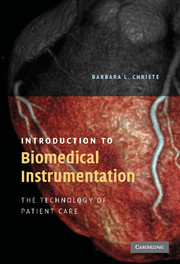Book contents
- Frontmatter
- Contents
- Preface
- INTRODUCTION TO BIOMEDICAL INSTRUMENTATION
- 1 BMET as a career
- 2 Patient safety
- 3 In the workplace
- 4 Electrodes, sensors, signals, and noise
- 5 The heart
- 6 Cardiac assist devices
- 7 Blood pressure
- 8 Respiration and respiratory therapy
- 9 The brain and its activity
- 10 The intensive care unit
- 11 The operating room
- 12 Imaging
- 13 Clinical laboratory equipment
- 14 Intravenous pumps and other pumps
- 15 Miscellaneous devices and topics
- Index
4 - Electrodes, sensors, signals, and noise
- Frontmatter
- Contents
- Preface
- INTRODUCTION TO BIOMEDICAL INSTRUMENTATION
- 1 BMET as a career
- 2 Patient safety
- 3 In the workplace
- 4 Electrodes, sensors, signals, and noise
- 5 The heart
- 6 Cardiac assist devices
- 7 Blood pressure
- 8 Respiration and respiratory therapy
- 9 The brain and its activity
- 10 The intensive care unit
- 11 The operating room
- 12 Imaging
- 13 Clinical laboratory equipment
- 14 Intravenous pumps and other pumps
- 15 Miscellaneous devices and topics
- Index
Summary
LEARNING OBJECTIVES
1 list and describe what a sensor does
2 identify the two types of transducers and describe examples of each type
3 list and describe the sources of error in sensor systems
4 list and describe the four types of electrodes (surface, micro, indwelling, and needle)
5 list and describe the sensors that are used to record direct blood pressure and temperature
6 list and describe impedance matching and patient impedance
7 list and describe human periodic, static, and random signals
8 characterize human signals as analog and medical devices as digital
9 describe electrical noise, especially related to the clinical setting
Introduction
The most common activity in patient care is patient monitoring. The human body produces a variety of physiological signals, and physicians have learned to interpret these signals to provide information about the health of a patient. To measure or monitor these signals, there must be a connection between the patient and some (typically electronic) device. This type of activity is called in vivo monitoring, which refers to the living patient. This chapter explores the machine-human connection.
Sensors
Sensors (often called transducers – the difference is unimportant here) convert the energy of the patient (pressure, for example) into a form that can be used by an instrument.
- Type
- Chapter
- Information
- Introduction to Biomedical InstrumentationThe Technology of Patient Care, pp. 53 - 68Publisher: Cambridge University PressPrint publication year: 2009



